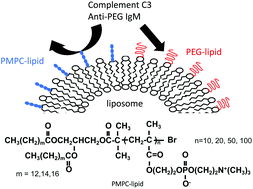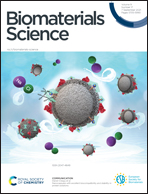Synthesis of poly(2-methacryloyloxyethyl phosphorylcholine)-conjugated lipids and their characterization and surface properties of modified liposomes for protein interactions†
Abstract
Poly(ethylene glycol) (PEG) is frequently used for liposomal surface modification. However, as PEGylated liposomes are cleared rapidly from circulation upon repeated injections, substitutes of PEG are being sought. We focused on a water-soluble polymer composed of 2-methacryloyloxyethyl phosphorylcholine (MPC) units, and synthesized poly(MPC) (PMPC)-conjugated lipid (PMPC-lipid) with degrees of MPC polymerization ranging from 10 to 100 (calculated molecular weight: 3 to 30 kDa). In addition, lipids with three different alkyl chains, myristoyl, palmitoyl, and stearoyl, were applied for liposomal surface coating. We studied the interactions of PMPC-lipids with plasma albumin, human complement protein C3 and fibrinogen using a quartz crystal microbalance with energy dissipation, and found that adsorption of albumin, C3 and fibrinogen could be suppressed by coating with PMPC-lipids. In particular, the effect was more pronounced for PMPC chains with higher molecular weight. We evaluated the size, polydispersity index, surface charge, and membrane fluidity of the PMPC-lipid-modified liposomes. We found that the effect of the coating on the dispersion stability was maintained over a long period (98 days). Furthermore, we also demonstrated that the anti-PEG antibody did not interact with PMPC-lipids. Thus, our findings suggest that PMPC-lipids can be used for liposomal coating.



 Please wait while we load your content...
Please wait while we load your content...